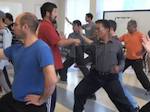”Collapse” is when a movement causes the loss of the original structure.
This is a common mistake in the learning of Taijiquan. As long as one moves, one will collapse to some degree. Therefore, it is not possible to get rid of the ill of collapse. One can only learn to reduce this mistake.
Another point about this is that collapse is not restricted to one direction. Normally people only think of downward falling movement as collapsing. It is not entirely true. Collapse is the change of angles in the joints. It can be in any joint and in any direction. For example, when the shoulder pokes up, it is a mistake of upward collapse. When the kua goes lower than the knee, it is a downward collapse.
Collapse can be masked by the presence of power. When someone is very strong, he will not easily collapse even though he might have made the mistakes of collapsing.
Originally published on Nov 26, 2007



{ 3 comments… read them below or add one }
[quote]Collapse can be masked by the presence of power. When someone is very strong, he will not easily collapse even though he might have made the mistakes of collapsing.[/quote]
So this is how my taiji brothers beat me!!!!
Not only that, I guess this is how points are made in Pushhands Competitions in about 95 % of all cases … right?
In engineering there is a concept called a “Cascading Failure”. Structural systems are designed to be reliant on the interrelationship between the various components in the system. Often, if even one component becomes defective and fails, it shifts an overload to the remaining components, which are not designed to deal with the extra force and new angular relationships caused by the initial flaw or failure. This causes a “cascade” effect, rippling through the whole structure causing complete collapse.
The same is true with the “tensegrity” or tensional integrity of our bodies. The structural relationship we set up between the ground and our opponents forces relies on a dynamic of bones pushing, and tendons pulling, creating temporary stability, but if our opponent causes a protrusion (such as shoulder popping “upward collapse”) or indentation (kua folding “downward collapse”) it can trigger the failure of our entire body.
http://en.wikipedia.org/wiki/Tensegrity